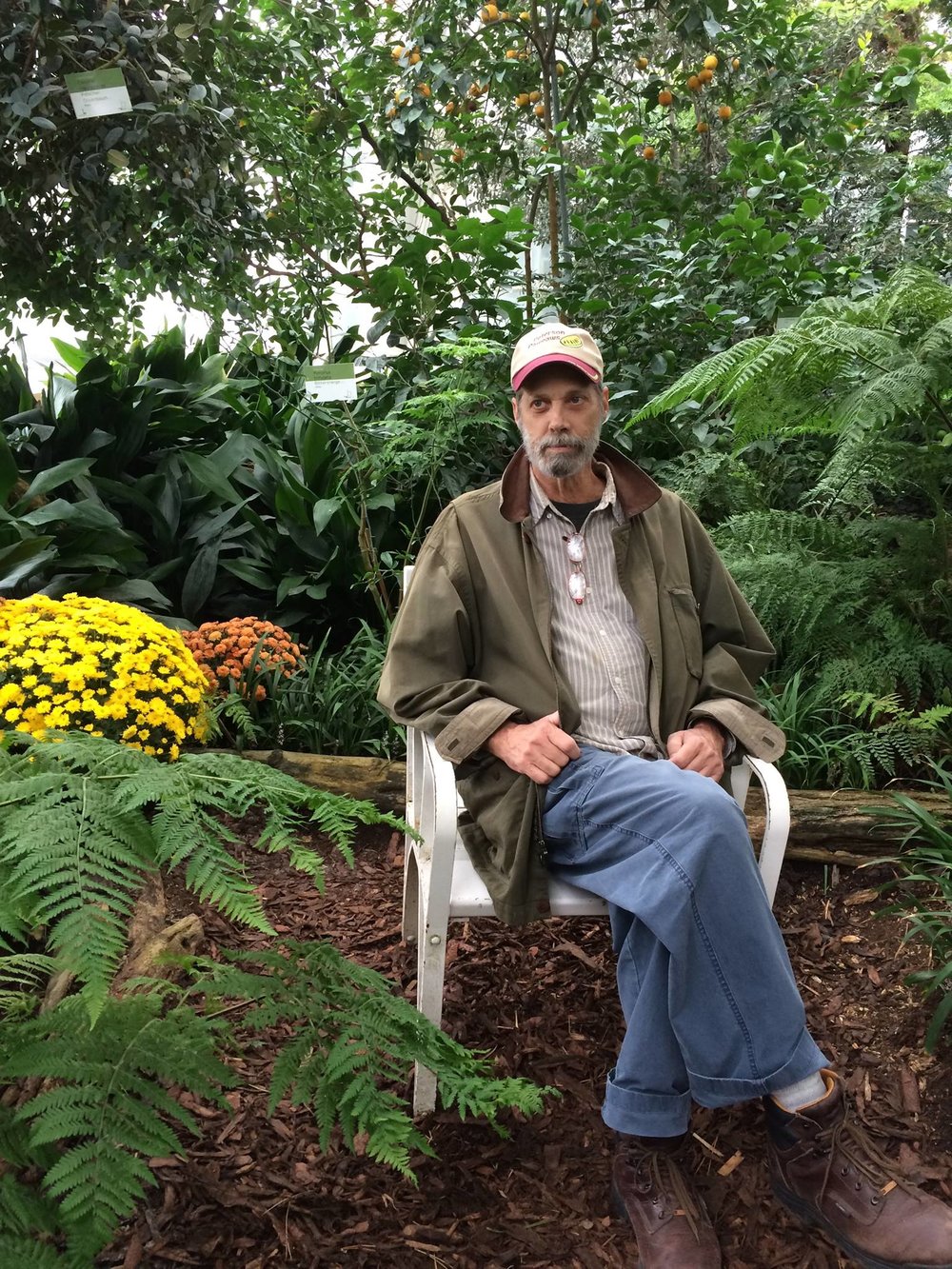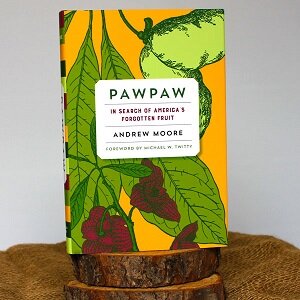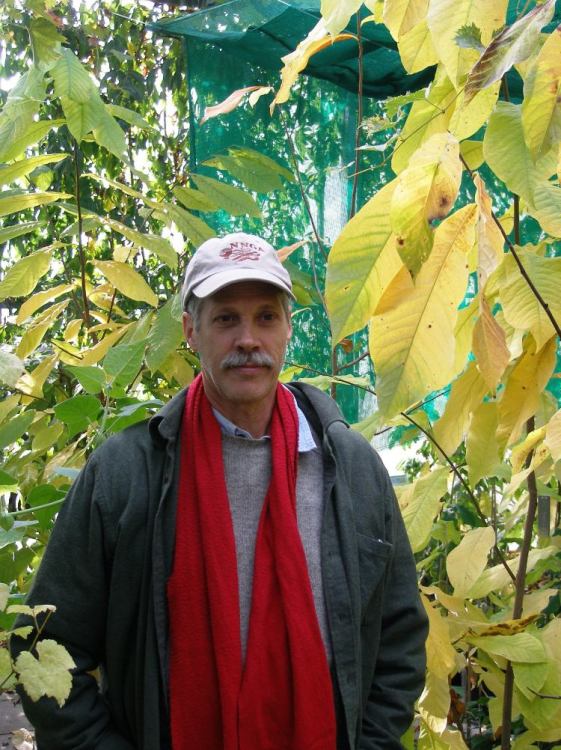Neal’s Story
A Love for Pawpaws Begins
In 1975, while he was studying for his master’s degree in plant genetics at West Virginia University, Neal Peterson tasted his first pawpaw.
It was fall. He was in the WVU arboretum, hiking a path along the flood plain of the Monongahela River, when he spotted a patch of pawpaw trees growing on a bank. Their slender trunks leaned this way and that, reaching out towards the light. The scent of fruit was in the air. Ripe pawpaws lay in the fallen leaves. He bent down and picked one up, lifted it to us lips. It smelled delicious. Why not? Why not try it? He bit into it. A revelation. It was delicious!
He had known pawpaw trees all his life – they grew in the woods behind his boyhood home in southern West Virginia, and he was always in the woods as a teenager. He admired the tree for their tropical-looking foliage and their curious wine-colored flowers. But for reasons forgotten to him, he had never tasted the fruit. Until then. “How come something that tastes this good has never been domesticated?”, he asked himself. “Why is it not being cultivated and sold in grocery stores?”
It tasted much better than cattail pollen and Jack-in-the-pulpit root, things his friend Nick Fedorko had prepared for him. This was not merely survival fare. This was a delicacy!
And with that the germ of an idea was planted in Neal’s brain that grew in time, and eventually became the saga of his life.
In 1975, while he was studying for his master’s degree in plant genetics at West Virginia University, Neal Peterson tasted his first pawpaw.
It was fall. He was in the WVU arboretum, hiking a path along the flood plain of the Monongahela River, when he spotted a patch of pawpaw trees growing on a bank. Their slender trunks leaned this way and that, reaching out towards the light. The scent of fruit was in the air. Ripe pawpaws lay in the fallen leaves. He bent down and picked one up, lifted it to us lips. It smelled delicious. Why not? Why not try it? He bit into it. A revelation. It was delicious!
He had known pawpaw trees all his life – they grew in the woods behind his boyhood home in southern West Virginia, and he was always in the woods as a teenager. He admired the tree for their tropical-looking foliage and their curious wine-colored flowers. But for reasons forgotten to him, he had never tasted the fruit. Until then.
“How come something that tastes this good has never been domesticated?” he asked himself. “Why is it not being cultivated and sold in grocery stores?” It tasted much better than cattail pollen and Jack-in-the-pulpit root, things his friend Nick Fedorko had prepared for him. This was not merely survival fare. This was a delicacy! And with that the germ of an idea was planted in Neal’s brain that grew in time, and eventually became the saga of his life.
Literature Search and a National Contest for the Best Pawpaw, 1916
Now the first thing to do when starting an enormous project that will challenge one’s ability to surmount obstacles and persevere in adversity is this: Assume the attitude of a religious, don the habit of humility, and make pilgrimage to a temple of learning. Seek the wisdom of the ages and of the sages, written in books and journals. Visit a library.
In a library you never know what you will discover – something that might save you from taking a turn down a wrong path – something that might show you that someone else has pursued your idea already, perhaps with success, perhaps with failure.
Checking the library has prevented many a man and woman from re-inventing the wheel. It has stimulated progress as it has made possible for fresh work to be built upon the foundations of work by others. Discover what discoverers before you have done. This is the essence of scholarship. Sir Isaac Newton said, “If I have seen further, it is by standing upon the shoulders of Giants.”
Heeding this advice, Neal hied himself to the WVU library. He traced the catalogs and scientific journal indexes for the words pawpaw and paw paw and papaw and Asimina triloba. He supposed he would find little. After all, the pawpaw was a wild species, was it not, unappreciated and neglected. Who has ever heard of pawpaw orchards or of named pawpaw varieties?
But much to his surprise, Neal discovered an amazing story. The Journal of Heredity had sponsored a national contest in 1916 that uncovered scores of outstanding clones of pawpaw, known locally to folks from Maryland to Kansas. Benjamin Buckman had collected nine named! varieties from correspondents scattered across the Midwest and Ozarks. In 1905 James A. Little had published a small treatise on the pawpaw that describes his breeding efforts, the first named pawpaw variety bred by him, called ‘Uncle Tom’, and his planting of a pawpaw orchard.
Listen to Neal’s Interview with Long Haul Productions on SoundCloud.
Read Neal's Breeding Project (PDF)
Pawpaw Variety Development: A History and Future Prospects
Neal's Full Story
But much to his surprise, Neal discovered an amazing story.
The Journal of Heredity had sponsored a national contest in 1916 that uncovered scores of outstanding clones of pawpaw, known locally to folks from Maryland to Kansas. Benjamin Buckman had collected nine named! varieties from correspondents scattered across the Midwest and Ozarks. In 1905 James A. Little had published a small treatise on the pawpaw that describes his breeding efforts, the first named pawpaw variety bred by him, called ‘Uncle Tom’, and his planting of a pawpaw orchard.
David Fairchild grew seedling pawpaws from the prize-winning fruit of the 1916 contest. And in the 1941 Journal of Heredity, George A. Zimmerman described his collection of over 60 named varieties and of his successful hybridizations between different species of Asimina. The Northern Nut Growers Association had been studying and writing about pawpaw since 1911. The 1958 annual report of the NNGA described how Zimmerman’s collection had been donated in 1941 to the Blandy Experimental Farm, an institution that had been collecting pawpaw since 1926.
But this exciting story only deepened the mystery of the pawpaw. All this work had been done early in the 20th century, and yet in 1975 the pawpaw was little known. Why was it not available in grocery stores? Where were the orchards? Why was the pawpaw not a commercial crop like the blueberry or the pecan, two native American species that had been successfully domesticated? What had become of those 60 varieties in Zimmerman’s collection?
The mystery deepened Neal’s resolve. As a student of genetics he knew that the first task in plant breeding was to assemble the best germplasm available. Now it became obvious that collecting superior pawpaw germplasm would not require combing the hills and hollows of 25 States where the pawpaw grew natively – a task that no individual could accomplish, not in 25 lifetimes. Nor did it require a new national contest. Nor a massive advertising campaign to reach the few old-timers & pawpaw lovers who still knew where the best pawpaws grew. The necessary work of finding the best pawpaws had already been accomplished a century before.
All that was required was tracking down the old collections of Buckman, Fairchild, Zimmerman and Blandy. That and a large dose of good fortune, that a remnant of their original trees should survive or, if not the original trees, then at least offspring that carried in their DNA the superior genes of their parents.
The Search for Historical Collections of Pawpaw
In many ways searching for those historic collections was the most exciting part of the pawpaw adventure for Neal. He was just beginning with pawpaws. He was still young. He had not encountered setbacks and disappointments. It was a time of innocence, free of the responsibilities that the breeding project later carried.
The search meant sleuthing for old properties. He visited County Court Houses and searched through musty deed books. He remembers dimly lit reading rooms with high-ceilings and gilt Florentine decor. His search led him to look for relatives. He wrote or phoned extension agents in Illinois and Pennsylvania. He drove down country roads, inquired with elderly strangers who may have been Zimmerman’s neighbors.
“Fern Hill. Have you ever heard of Fern Hill? That was where Dr. Zimmerman lived, the name he gave his home. Did you know him? Do you know where the property is?”
Neal remembers the excitement of finding a country driveway flanked by square stone columns bearing a bronze plaque that said Fern Hill. He remembers driving up to the original stone house that Zimmerman built, and meeting the current occupants, the only occupants since Zimmerman’s widow died in the 1960s. It was a lovely house, designed by Zimmerman, built of fieldstone, hidden back in the woods – oaks, maples, hickories, some pine, many large trees. Small and large pawpaw trees were everywhere but in no apparent order or arrangement, as if growing wild. No orchard. No rows.
But then there was the ah-ha moment when walking through the woods, a series of older pawpaw trees suddenly lined up in a single row. He had found something Zimmerman had planted! He didn’t know what. There were no identifiers, no labels on the trees. But clearly this was a row. Later Neal and Dr. Harry Swartz of the University of Maryland would drive up there to collect fruit.
In retrospect, it is clear that none of the fruit at Zimmerman’s was of special quality (unlike the fruit later discovered at Blandy). That is not difficult to understand. The named cultivars in Zimmerman’s collection would naturally have been grafted by Zimmerman from scion wood that cooperators mailed him. Forty years since Zimmerman’s death is a long time in the life of a pawpaw tree. Doubtless the tops, the grafts, had died.
If the genes were present on the property they would be in the smaller seedling trees scattered about. In the depths of the forest, with so little sunlight, there was very little fruit. Despite the lack of wonderful quality fruit, this was still a start and a positive development in the collection of germplasm. Better things would come when Neal got to Blandy…




